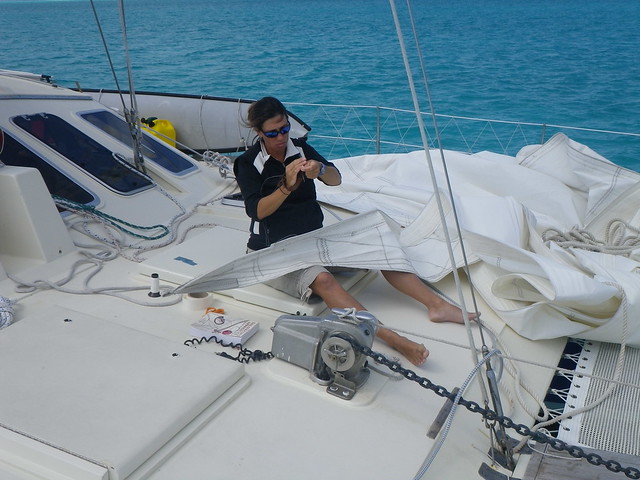The electrical system is arguably the most important system on Take Two. When docked at a marina, the electricity we use comes to us through a shore power cord just like it would in a house. The power is virtually unlimited and we can run heavy loads like air conditioning without giving a thought to how much we’re using. But away from the dock, the only constant supply of power we have is from batteries with a limited capacity, and we have to use intermittent sources like generators and solar panels to recharge them. Thinking about power is part of our daily life.
Our current setup is four Lifeline 8D absorbed glass mat (AGM) lead-acid batteries providing a 510 amp-hour (theoretical) capacity at 24 volts. We charge the batteries through a pair of Trace PS 2524 inverter/chargers with a combined charging current of 130A. The chargers are supplied by a split-phase 12kW Northern Lights diesel generator burning 0.4 gallons/hour.
The generator is set up to be controlled by a GSCM from Atkinson Electronics. We send start and shutdown signals to the GSCM from a Flexcharge programmable timer. Automating the generator this way allows us a degree of flexibility to leave the boat unattended, but also helps keep things on schedule in case we aren’t paying attention.
We can monitor the battery state of charge with a Victron battery monitor. It measures the current flowing in and out of the batteries and attempts to calculate how much capacity remains, and how much time until we have to charge. The monitor also has relay outputs that we can use to manage the GSCM.
For a while, we had things set up so the battery monitor decided when to start and stop the generator based on battery state of charge, and we used the timer to institute quiet times when the generator wasn’t allowed to run. Practice showed that generator runs were longer and more consistent than we anticipated, and the monitor did not remain accurate for more than a couple days without a full recharge to synchronize it. The straight timer approach proved simpler and more predictable.
When you live on a boat you get tuned in to every sound and motion. It can be a little nerve-wracking to have a big generator starting and stopping at random times. Besides, we like being able to plan activities like running the vacuum cleaner and clothes washer for times when the power is “free”.
For the health of the batteries, they should never be discharged below 50% and really should always be charged back up to 100%. But due to internal resistance, all lead-acid batteries heat up and accept less current as they approach a full charge. So recharging to 100% takes a lot of time, about six hours for us. This isn’t a generally a concern when unlimited shore power is available, but is impractical to do with a generator.
Instead, we stop the big generator after charging for an hour and a half. Typically the current being accepted by the batteries is below 40A by that point, which is about 80% full. This is not great for the batteries, and we’re probably significantly decreasing their advertised life span (measured in discharge cycles).
We had hoped when we installed our 750W solar panel array that they would provide enough power to top up the batteries after the generator does the bulk charging, but it doesn’t really work out that way. After the refrigeration and water maker loads, there isn’t much left for the batteries.
We would like to add a pair of wind generators to help out with this. We’ve observed other boats’ turbines spinning away on cloudy days and dark nights with envy (and irritation). But wind generators are not subtle things, and we have yet to figure out how to mount them unobtrusively on Take Two.
Instead, about once a week we fire up our little Honda 1000 gas generator to get a full charge on the batteries. The Honda is inverter-based, meaning it is a DC generator that uses an inverter to form its AC output. The boat’s chargers then turn that AC back into DC for the batteries. While there is some loss from all these conversions, a DC generator is able to reduce its engine speed when demand is low, which saves fuel and makes it perfect for finish charging a lead-acid battery during its low-acceptance phase.
AC generators like our big diesel must run at a constant speed regardless of load in order to make the correct line frequency. And diesels like heavy loads. So a light load on an AC diesel generator wastes fuel and wears on the engine.
The dilemma we face now is what to do with this situation. We don’t particularly want to bite off any huge projects, so the answer may simply be that we keep on as we have been. By far the cheapest option is to continue burning diesel. But we may not have that option for long. The generator is 13 years old and the inverter/chargers are 10.
So as we near the end of life on some of our more expensive pieces of equipment, we need to at least have a strategy in mind for how we’re going to manage our power needs in the future. And it would be really nice to replace something before it fails. If our big generator were to die today we’d be in a real pinch to replace the power it provides.
The primary focus of our next electrical system will be to reduce our dependency on diesel and the machines that convert it to electricity. That doesn’t necessarily mean that we expect to be rid of diesel entirely, but we want to use less of our fuel capacity for daily power, and we never want the failure of a single device to be catastrophic. If we’re going to depend on a diesel generator, it will need some kind of equivalent backup.
I think there are several aspects to a full solution:
* We should reduce our daily power usage. We have no desire (and little ability) to become misers. If anything, our personal usage is only going to go up as our kids get bigger; more food, more laundry, and more showers. Our best opportunity to use less power is probably to upgrade our current AC-powered refrigeration to more efficient DC-powered units. This would also reduce our need to have an inverter powered up 24/7.
* We should increase our ability to charge from alternative (non-diesel) sources. We already have a decent amount of solar, so wind seems like a logical next step.
* When our current batteries die, we should change to batteries that we can charge on our own terms without risk of damaging them. I want the bank to have enough capacity that we don’t have to charge them every day, and can afford to wait for the sun to shine or the wind to blow. When a generator is running, I want those batteries to take max charge current until they’re full. No more of this acceptance rate business. I think Lithium-Ion (LiFePO4) makes this possible.
* Finally, any future generator should be sized (and the corresponding chargers also), so that the engine operates at a healthy load and uses fuel efficiently.
Hopefully we have a while yet to ponder all of this, and won't have to do it all at one time.









